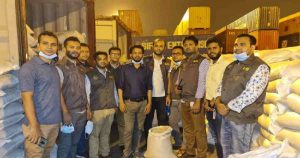Dhaka, July 22 – Although floodwater started to recede from many areas in the flood-affected northern and northeastern districts of Bangladesh, the victims were going through immense sufferings for want to food and safe drinking water. Besides, many were affected by water-borne diseases.
Floodwater started to recede from many affected areas. However, many rivers were still flowing above the danger level.
In Gaibandha, the water level of the Brahmaputra and Ghaghot rivers has decreased. But they were still following 101 cm and 53 cm above the danger level respectively on Sunday afternoon, according to Water Development Board (WDB) sources.
Meanwhile, the Koratoa River was flowing 3 cm above the red mark.
An acute shortage of food, drinking water and fodder hit hard 485,328 people at 383 villages under 49 unions in the district.
Besides, they were facing a sanitation crisis.
Md Abdul Matin, Deputy Commissioner of the district, said at least 44,792 houses were damaged by the flood in the district while 74,104 people have taken shelter in 180 shelter centres.
The district administration was distributing 950 tonnes of rice, Tk 10.50 lakh and 5,600 packets dry food among the victims, he said.
In Sherpur, a child drowned and another was electrocuted on Sunday amid flood in Sreebardi Upazila.
The deceased were identified as Kabita Begum, 11, daughter of Shamsul Alam of Jhograr Char area, and Ripa Akhter, 14, daughter of Intaz Ali of Dhatiapara area.
Locals said there was an outbreak of water-borne diseases in the affected areas.
The Old Brahmaputra River was flowing 14 cm above the danger level while vast areas of nine unions were flooded after a river embankment collapsed at different spots.
Traffic on the Sherpur-Dhaka highway remained halted for the last three days while some 52 educational institutions closed due to flood.
Meanwhile, Md Atiur Rahman Atik, Whip and Sherpur-1 MP, distributed relief and medicines among the affected people on Sunday.
In Kurigram, about 8 lakh people were stranded as the overall flood situation remained unchanged in the district.
Although the water level of the major rivers has decreased, the sufferings of people mounted due to the shortage of drinking water, food, fodder and fuel.
Kurigram Civil Surgeon Dr SM Aminul Islam said 85 medical teams were working in the flood-hit areas. The district administration was also distributing water purification tablets and saline among the victims.
The district administration’s control room sources said 73 unions in nine Upazilas were flooded. Farmers in particular face an uncertain future as 20,000 hectares of cropland were submerged.
The flood also damaged 1,245 km of road, 40 kms of embankment and 41 bridges and culverts. Over 9,734 tube wells were underwater.
The Brahmaputra and Dharala rivers were flowing 63 cm and 23 cm above the danger level respectively in the district, according to Kurigram WDB.
A total of 755 educational institutions, including 128 secondary schools, 70 madrasas, 17 colleges and 540 primary schools, had to suspend academic activities due to rising water. Among the district’s 1,240 government primary schools, 536 had been flooded.
The district administration has distributed 5 tonnes of rice, Tk 13.5 lakh and 3,000 packets of dry food among the flood-affected people.
In Munshiganj, the mighty Padma kept swelling till Sunday while its erosion took a serious turn devouring homesteads of 70 families in Louhajang upazila in the last three days, said Zakir Hossain, Kumarbhog Union Parishad Chairman.
Rafiz Uddin, a retired Army officer, said the erosion intensified due to the frequent anchorage of large ships and trawlers along the banks.
Meanwhile, vast areas of char land were flooded leaving several thousand people marooned.
Md Kabirul Islam Khan, Lohajang Upazila Nirbahi Officer, said they are aware of the erosion at Khoria which is under Padma Bridge’s river management. – UNB




